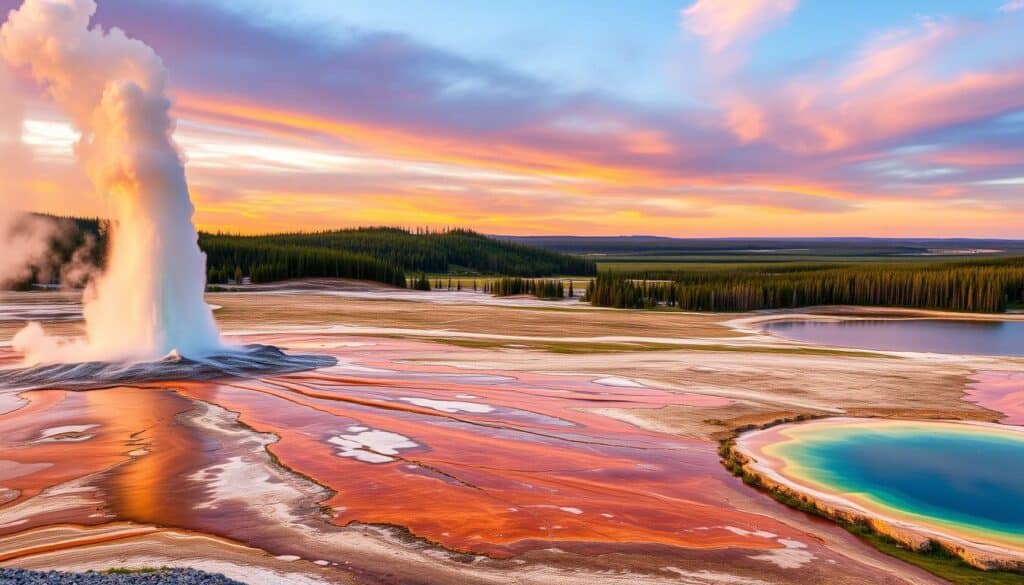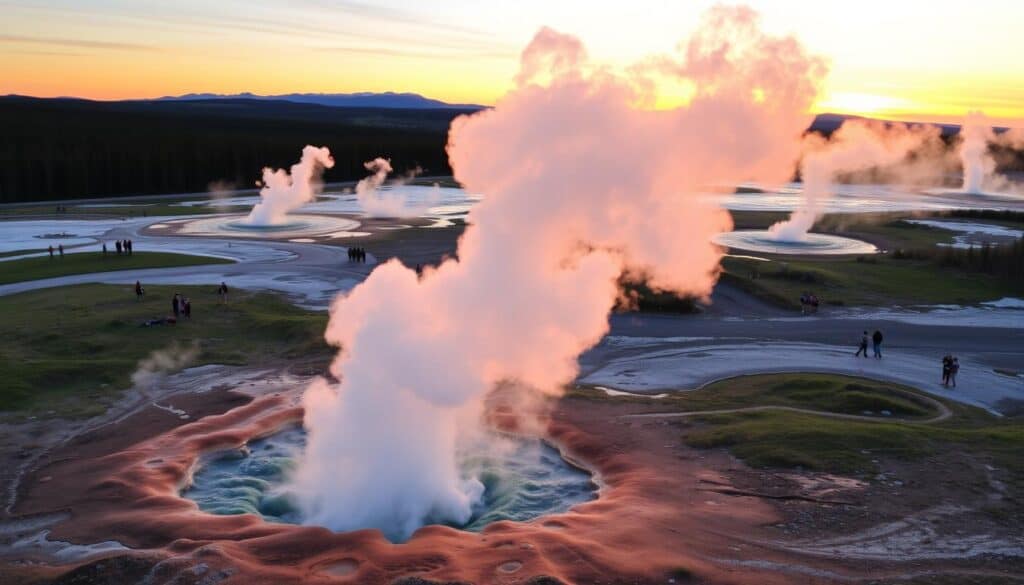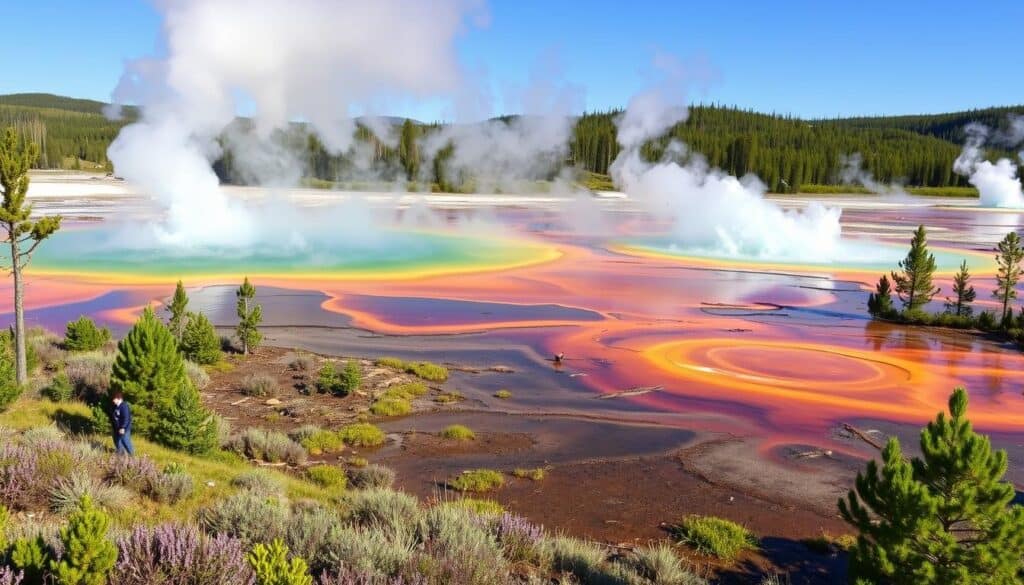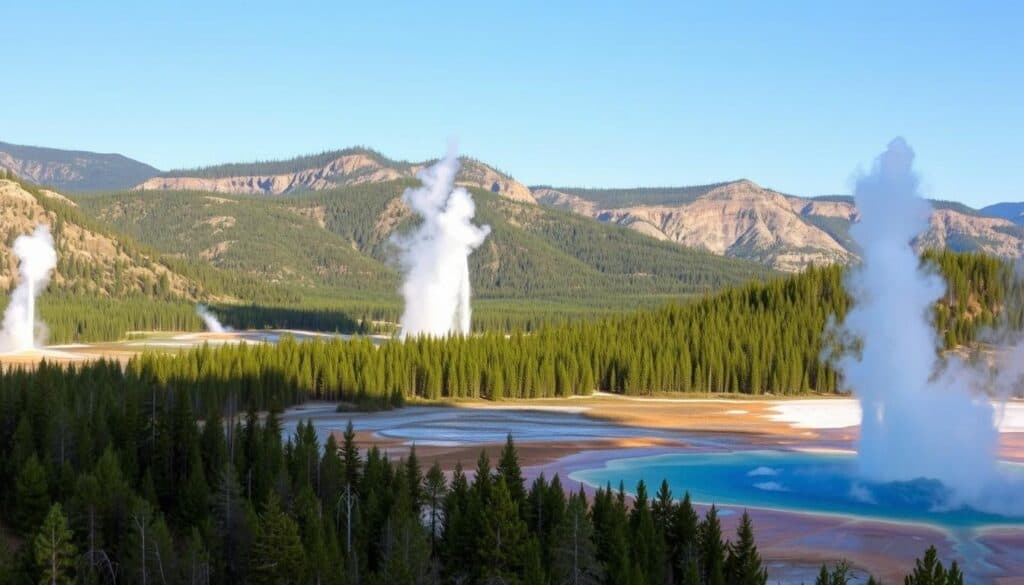Yellowstone National Park is home to more geysers than anywhere else in the world, with thousands of geothermal features scattered throughout the park. The best geysers in Yellowstone, including Old Faithful, are a must-see for anyone visiting the park. Yellowstone National Park geysers are a unique and fascinating sight, with thousands of geothermal features, including hot springs, pools, fumaroles, and mudpots.
With over 500 geysers located in Yellowstone National Park, visitors can witness the spectacular display of geological wonders. The park’s geysers, including Old Faithful, are a result of the molten rock or magma under Yellowstone, which is estimated to be 3 to 8 miles underground. Yellowstone National Park geysers, such as Old Faithful, erupt with an average interval of about 90 minutes, varying from 50 to 127 minutes, making them a popular attraction for visitors.
Key Takeaways
- Yellowstone National Park is home to over 500 geysers, including Old Faithful.
- The best geysers in Yellowstone are a result of the park’s unique geothermal features.
- Yellowstone National Park geysers, such as Old Faithful, erupt with an average interval of about 90 minutes.
- The park’s geysers are a popular attraction for visitors, with thousands of geothermal features to explore.
- Visitors can witness the spectacular display of geological wonders at Yellowstone National Park.
- Old Faithful is one of the six geysers that can be predicted by park rangers, making it a must-see for visitors.
The Geological Marvels of Yellowstone National Park
Yellowstone National Park is home to over 10,000 hydrothermal features, including more than 500 famous yellowstone geysers. These natural wonders are a result of the park’s unique geology, with a combination of heat, water, and rock creating the perfect conditions for geysers to form.
One of the most interesting yellowstone geyser facts is that geysers have constrictions in their plumbing systems that prevent water from moving freely to the surface, creating a buildup of steam that eventually leads to an eruption. This process is fascinating, with the buildup of steam in the plumbing system leading to eruptions that can reach heights of over 100 feet.
Some notable yellowstone geyser facts include:
- Old Faithful eruptions regularly reach heights of more than 130 feet.
- The Upper Geyser Basin, where Old Faithful is located, contains approximately 150 geysers within an area of about 1 square mile.
- The interval between eruptions has varied over time, with an average interval of approximately 94 minutes.
Understanding the science behind geysers and the role of hydrothermal features in the park’s ecosystem is essential to appreciating the beauty and complexity of Yellowstone National Park. By exploring these yellowstone geyser facts, we can gain a deeper appreciation for the natural wonders of this unique park.
Iconic Geysers You Can’t Miss
Yellowstone National Park is home to over 500 geysers, with some being more iconic than others. When planning your yellowstone geyser tours, there are a few must-see geysers that you shouldn’t miss.
Old Faithful: The Famous Eruptor
Old Faithful is one of the most famous geysers in the world, erupting roughly every 60 to 110 minutes. This geyser is a must-see during your must-see yellowstone geysers tour, with an eruption lasting 1.5 to 5 minutes and expelling 3,700-8,400 gallons of boiling water.

Castle Geyser: A Spectacular Show
Castle Geyser is another iconic geyser in Yellowstone, offering a unique and spectacular display of geological wonder. This geyser is a great example of the natural beauty that can be seen during a yellowstone geyser tours.
Grand Geyser: Nature’s Timed Performance
Grand Geyser is the largest predictable geyser in the world, erupting every 7 to 15 hours. This geyser is a must-see during your visit to Yellowstone, and is a great example of the natural wonders that can be seen during a must-see yellowstone geysers tour.
The Eruption Cycle: What to Expect
Yellowstone National Park is home to over 10,000 hydrothermal features, including more than 500 geysers. Understanding the eruption cycle of these geysers is essential for planning your visit and making the most of your experience. Yellowstone geyser eruption times can be affected by various factors, including temperature, pressure, and the amount of water in the system.
To observe geysers safely and enjoy the experience, it’s crucial to follow yellowstone geyser viewing tips. This includes maintaining a safe distance, staying on designated trails, and being aware of your surroundings. By doing so, you can appreciate the unique eruption cycles characteristic of Yellowstone geysers.
How Geysers Erupt
Geysers erupt when water is heated by superhot magma from the Yellowstone volcano, with the hot water traveling underground through cracks and fissures before reaching the surface. This process can be influenced by factors such as humidity and heat, which support the growth of thermophiles (heat-loving microorganisms) in the hydrothermal features.
Factors Affecting Eruption Times
The eruption times of geysers can be affected by various factors, including the amount of water in the system, pressure, and temperature. For example, the average eruption duration of geysers like Old Faithful is approximately 3 minutes and 35 seconds. However, other geysers like Aurum Geyser can erupt nearly 30 times over a 14-day period, with variations in height, duration, and frequency.
Observing Geysers Safely
To observe geysers safely, it’s essential to follow guidelines and regulations. This includes maintaining a safe distance, staying on designated trails, and being aware of your surroundings. By doing so, you can appreciate the unique eruption cycles characteristic of Yellowstone geysers and enjoy the experience while ensuring your safety.
| Geyser | Eruption Duration | Eruption Frequency |
|---|---|---|
| Old Faithful | 3 minutes 35 seconds | Every 60-110 minutes |
| Aurum Geyser | Varies | Nearly 30 times over 14 days |
| Beehive Geyser | Varies | Every 18-22 hours |
Geysers Versus Hot Springs: The Differences
Yellowstone National Park is home to a diverse range of hydrothermal features, including geysers and hot springs. While both are unique and fascinating, they differ in their eruption patterns and characteristics. Geysers, such as the best geysers in Yellowstone, are more explosive, with water being ejected into the air, whereas hot springs are more stable, with water flowing gently to the surface.
Some key differences between geysers and hot springs include:
- Temperature: Geysers can reach temperatures of up to 174 °C (345 °F), while hot springs typically have lower temperatures, around 60 °C (140 °F) to 70 °C (160 °F).
- Eruption pattern: Geysers erupt periodically, with some, like Old Faithful, erupting approximately every 92 minutes, while hot springs have a more constant flow of water.
- Chemical composition: Geysers and hot springs have different chemical compositions, with geysers often having higher concentrations of minerals and gases.
Both geysers and hot springs are important features of Yellowstone National Park geysers, and understanding their differences can help appreciate the unique characteristics of each. By exploring these hydrothermal features, visitors can gain a deeper understanding of the park’s geology and ecosystem.
https://www.youtube.com/watch?v=zEJWrTECg7E
| Feature | Geysers | Hot Springs |
|---|---|---|
| Temperature | Up to 174 °C (345 °F) | 60 °C (140 °F) to 70 °C (160 °F) |
| Eruption pattern | Periodic eruptions | Constant flow of water |
| Chemical composition | Higher concentrations of minerals and gases | Lower concentrations of minerals and gases |
Best Viewing Locations in the Park
Yellowstone National Park offers a range of viewing locations for geysers, each with its unique characteristics and attractions. For an unforgettable experience, consider taking yellowstone geyser tours that cater to your interests and schedule.
The Upper Geyser Basin is a must-visit destination, home to the majority of the world’s active geysers, including Old Faithful. To make the most of your visit, follow these yellowstone geyser viewing tips:
- Arrive early to secure parking and beat the crowds
- Wear comfortable shoes and dress in layers for changing weather conditions
- Bring a map and guide to help navigate the area and identify geysers
In addition to the Upper Geyser Basin, other notable locations include the Norris Geyser Basin and Old Faithful Village. These areas offer a range of visitor services and amenities, making them ideal for yellowstone geyser tours.

By following these tips and taking a guided tour, you can enhance your yellowstone geyser viewing experience and create lasting memories of your visit to Yellowstone National Park.
| Location | Features | Services |
|---|---|---|
| Upper Geyser Basin | Old Faithful, other geysers | Parking, restrooms, food and drink |
| Norris Geyser Basin | Unique geothermal features | Parking, restrooms, trails |
| Old Faithful Village | Visitor center, lodging, dining | Guided tours, amenities |
Tips for Photographing Geysers
Photographing geysers in Yellowstone National Park can be a challenging but rewarding experience. To capture the perfect shot, it’s essential to consider the best times for great photos, camera settings, and composition. The golden light of early morning or late evening provides a unique and captivating atmosphere, making it ideal for photographing yellowstone geyser viewing tips.
When visiting yellowstone national park geysers, it’s crucial to be prepared and plan your trip according to the season. Summer months see heavy traffic and limited parking availability around popular geyser locations. On the other hand, winter offers a serene and peaceful atmosphere, with the added bonus of capturing the Milky Way or aurora borealis.
Best Times for Great Photos
- Early morning: The soft, golden light provides a warm and inviting atmosphere.
- Late evening: The sky is painted with hues of orange and pink, making for a breathtaking backdrop.
By following these tips and considering the best times for great photos, you’ll be well on your way to capturing stunning images of Yellowstone’s geysers. Remember to always prioritize your safety and respect the park’s rules and regulations when photographing these natural wonders.
The Role of Geysers in Ecosystems
Yellowstone’s famous geysers, such as Old Faithful, play a crucial role in supporting biodiversity. The unique conditions surrounding these features support a range of flora and fauna, including microorganisms that thrive in hot water and minerals. Yellowstone geyser facts show that the park is home to over 500 active geysers, which is more than half of the world’s total geysers.
The geothermal features in Yellowstone provide a habitat for a variety of microorganisms that are found nowhere else on Earth. These microorganisms are able to survive in extreme conditions, such as high temperatures and acidic environments. The famous Yellowstone geysers are not only a wonder to behold but also support a complex ecosystem.

- Providing a source of food for microorganisms and other species
- Creating a unique habitat for plants and animals that are adapted to the geothermal environment
- Supporting a diverse range of flora and fauna, including species that are found nowhere else on Earth
Overall, the famous Yellowstone geysers and other geothermal features play a vital role in supporting the park’s ecosystem. By understanding Yellowstone geyser facts and the importance of these features, we can better appreciate the complexity and beauty of this unique environment.
| Geothermal Feature | Description |
|---|---|
| Geysers | Hot springs that erupt periodically, shooting water and steam into the air |
| Hot Springs | Natural springs that emit hot water, often containing minerals and microorganisms |
| Mudpots | Bubbling pools of mud and water, often found in areas with high geothermal activity |
Visiting Yellowstone: Planning Your Trip
Planning a trip to Yellowstone National Park requires careful consideration of several factors, including the best times to visit and how to get there. With millions of people visiting the park annually, it’s essential to be prepared for the unique geology and weather patterns of the area. For those interested in yellowstone geyser tours, the park offers a range of options, from guided tours to self-guided explorations of the yellowstone national park geysers.
To make the most of your trip, consider visiting during the spring and fall, when the weather is mild and the crowds are smaller. This is also an ideal time for yellowstone geyser tours, as the temperatures are more comfortable for hiking and exploring the park’s many hydrothermal features. When planning your trip, be sure to check the park’s website for up-to-date information on road closures and construction delays, as these can impact your travel plans.
Getting to Yellowstone is relatively easy, with several airports located nearby, including the Idaho Falls Regional Airport and the Bozeman Yellowstone International Airport. From there, you can rent a car or take a shuttle to the park. Once you arrive, be sure to download the National Park Service app, which includes offline content to help you navigate the park and stay safe.

When it comes to yellowstone geyser tours, there are several options to choose from, including guided tours and self-guided explorations of the park’s many yellowstone national park geysers. Some popular destinations include the Old Faithful and Upper Geyser Basin, as well as the Grand Prismatic Spring Overlook. Be sure to check the park’s website for up-to-date information on geyser eruption times and trail closures before you go.
| Month | Average Temperature (F) | Average Precipitation (in) |
|---|---|---|
| June | 65 | 2.5 |
| July | 73 | 2.2 |
| August | 72 | 2.1 |
By planning your trip carefully and being prepared for the unique conditions of Yellowstone National Park, you can have a safe and enjoyable experience exploring the park’s many yellowstone national park geysers and taking part in yellowstone geyser tours.
Conservation Efforts in Yellowstone
Yellowstone National Park is home to some of the most unique and fragile hydrothermal features in the world, including the famous yellowstone national park geysers. To protect these features, the park has implemented various conservation efforts. One of the key initiatives is the designation of the park’s hydrothermal features as a protected area.
Visitors to the park can also play a crucial role in conservation by following simple guidelines, such as staying on designated trails and not throwing objects into the geysers. By working together, we can help preserve the best geysers in yellowstone for future generations.
Some of the conservation efforts in Yellowstone include:
- Reducing energy consumption through the use of renewable energy sources
- Implementing sustainable waste management practices
- Protecting and preserving natural habitats and ecosystems
The park’s conservation efforts are crucial to maintaining the delicate balance of the ecosystem and ensuring the long-term health of the yellowstone national park geysers and other hydrothermal features.
| Conservation Effort | Goal |
|---|---|
| Reducing energy consumption | To minimize the park’s carbon footprint |
| Implementing sustainable waste management | To reduce waste and promote recycling |
| Protecting and preserving natural habitats | To maintain the health and diversity of the ecosystem |
Yellowstone’s geysers are not only a stunning natural wonder but also a source of endless fascination. From the record-breaking eruptions of the Steamboat Geyser to the unique names and origins of various geysers, there is no shortage of intriguingyellowstone geyser factsabout these hydrothermal features.
Fun Facts About Yellowstone Geysers
Record-Breaking Eruptions
Yellowstone is home to the world’s tallest active geyser, the Steamboat Geyser, which can reach heights of over 300 feet (91 meters) during its most powerful eruptions. This geyser has a history of impressive displays, with recent notable events, including a 2013 eruption after an eight-year dormancy and five eruptions in 2023 alone.
Unique Geyser Names and Their Origins
Many of Yellowstone’s geysers have been given unique and often whimsical names that reflect their characteristics or historical significance. For example, the iconic famous yellowstone geysers Old Faithful Geyser is named for its predictable eruption patterns, while the Castle Geyser is known for its castle-like appearance during eruptions. These names offer a glimpse into the park’s rich cultural and geological heritage.
Geysers in Popular Culture
Yellowstone’s geysers have captured the imagination of people around the world, appearing in various forms of popular culture. From films and television shows to literature and art, these remarkable natural features have become iconic symbols of the park and its stunning landscape. Visitors can even find geyser-themed souvenirs and memorabilia to commemorate their experiences in this one-of-a-kind destination.
